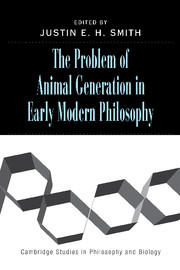Book contents
- Frontmatter
- Contents
- List of Contributors
- Introduction
- I THE DAWNING OF A NEW ERA
- II THE CARTESIAN PROGRAM
- III THE GASSENDIAN ALTERNATIVE
- 5 The Soul as Vehicle for Genetic Information: Gassendi's Account of Inheritance
- 6 Atoms and Minds in Walter Charleton's Theory of Animal Generation
- IV SECOND-WAVE MECHANISM AND THE RETURN OF ANIMAL SOULS, 1650–1700
- V BETWEEN EPIGENESIS AND PREEXISTENCE: THE DEBATE INTENSIFIES, 1700–1770
- VI KANT AND HIS CONTEMPORARIES ON DEVELOPMENT AND THE PROBLEM OF ORGANIZED MATTER
- VII KANT AND THE BEGINNINGS OF EVOLUTION
- Bibliography
- Index
5 - The Soul as Vehicle for Genetic Information: Gassendi's Account of Inheritance
Published online by Cambridge University Press: 06 August 2009
- Frontmatter
- Contents
- List of Contributors
- Introduction
- I THE DAWNING OF A NEW ERA
- II THE CARTESIAN PROGRAM
- III THE GASSENDIAN ALTERNATIVE
- 5 The Soul as Vehicle for Genetic Information: Gassendi's Account of Inheritance
- 6 Atoms and Minds in Walter Charleton's Theory of Animal Generation
- IV SECOND-WAVE MECHANISM AND THE RETURN OF ANIMAL SOULS, 1650–1700
- V BETWEEN EPIGENESIS AND PREEXISTENCE: THE DEBATE INTENSIFIES, 1700–1770
- VI KANT AND HIS CONTEMPORARIES ON DEVELOPMENT AND THE PROBLEM OF ORGANIZED MATTER
- VII KANT AND THE BEGINNINGS OF EVOLUTION
- Bibliography
- Index
Summary
INTRODUCTION
Generation and heredity theories before early modern mechanist accounts might be faulted for numerous deficits. One might cite in this regard the failure to even attempt to explain how the inheritance of traits could occur, given what is known about the generation of new individuals. On the other hand, it would be hard to allow this as a true failure against the backdrop of a generation theory that poses form, and not matter, as the key to understanding the emergence of new structures in the offspring of two organisms. Hence the signal contribution of the mechanist accounts in this sphere was simply the suggestion that theories of generation and heredity might look to matter and its behavior in order to explain how new individuals are created and retain or discard features of the individuals whence they sprung. Among these accounts, one early important set of views was presented by Pierre Gassendi, eventually as a full-blown atomist conjecture but even beforehand, and early on, as a thoroughgoing materialist theory.
Gassendi's materialist mechanism for the transmission of traits is imperfect (and by the common sense of our day, implausible), not always or exclusively deployed in generation, and not clearly the physical bearer of information, as conformity to a materialist model would suggest. Nonetheless, his proposed mechanism represents a valuable attempt to provide an account of inheritance phenomena in materialist and ultimately atomist terms and rooted in an account of generation.
- Type
- Chapter
- Information
- The Problem of Animal Generation in Early Modern Philosophy , pp. 103 - 123Publisher: Cambridge University PressPrint publication year: 2006
- 4
- Cited by



